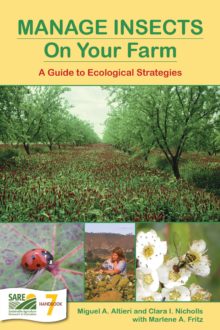
Farm Feature: Triple Threat to Pests: Cover Crops, No-Till, Rotation
- Uses cover crops to break up insect and disease cycles
- Releases parasites against pests
- Controls weeds with crop rotations, cover crops and no-till
- Uses no-till to conserve moisture
Since the early 1980s, Steve Groff has been building a sustainable farming system on the triple foundations of cover crops, intensive crop rotation and long-term no-tillage.
After more than 20 years — seven of them in no-till vegetables — Groff says he would “never come back” to conventional production. “I’m increasing beneficial insects to the degree that I’m getting a positive pest-control response. There’s no doubt about that,” he says. “But we haven’t ‘arrived’ yet.”
Crops need 40 percent less pesticide
Groff estimates that he has pared down pesticide use by 40 percent on his Cedar Meadow Farm in Lancaster County, Pa. By transplanting his 25 acres of tomatoes directly into rolled-down cover-crop mulch, he has sliced $125-an-acre from that crop’s pesticide bill alone. His cover-crop mixes of hairy vetch, crimson clover and rye — or vetch and rye alone when clover is too expensive — harbor beneficials. They also seem to obstruct, exhaust, confuse and otherwise inhibit Colorado potato beetles, discouraging their colonization, says Aref Abdul-Baki, USDA Agricultural Research Service vegetable production specialist. Likewise, the killed cover crop may be dissuading cucumber beetles in Groff’s 30 acres of pumpkins.
Groff says he hasn’t sprayed his tomatoes against Colorado potato beetles for the past seven years, nor has he used post-emergence chemicals against cucumber beetles in pumpkins. He can also delay protective sprays for early blight for three to seven weeks in his tomatoes: in conventional systems, heavy raindrops pick up disease spores on plants, wash them down to plastic mulch, then splash them back up onto the crop; Groff’s natural mulch lets spore-laden raindrops flow through to the ground, says Abdul-Baki. Similarly, the cover-crop mulch keeps his pumpkins cleaner and less prone to rot.
Integrated approach is essential
Although the mulches break up insect and disease cycles, Groff gives much of the pest-management credit to his long-term rotations. There’s no single “magic bullet,” he says: all three components of his system are equal partners.
In his 25 acres of sweet corn, Groff uses moth-trap monitoring to keep his corn earworm losses in check. In cooperation with a multi-state team of scientists led by Cornell University, Cedar Meadow Farm is also participating in investigatory releases of the parasitic wasp Trichogramma ostriniae against European corn borers.
For reasons he doesn’t quite understand, Groff says aphids trouble none of his crops. He credits beneficials.
In exceptionally dry years, Groff’s farm isn’t spared from significant spider mite damage. “Right now we don’t have a solution for that,” he says. “This system is not foolproof.” In wet years, he sees more slugs than his neighbors do. “Now, there is an instance where the residue and moisture definitely favor a pest,” he says. Because gardeners’ remedies like beer traps aren’t even remotely economical on 80 acres of vegetables, Groff is considering a “soft,” narrow-spectrum insecticide that targets slugs without threatening earthworms.
Weeds get the personal touch
Each of Groff’s fields has its own “recipe” for weed control. On his four-wheeler, he diligently scouts his crops, searching for small weeds and weighing his options. “It’s intensive management of weeds, and it’s not a second or third priority — it’s a top priority,” he says.
To control weeds, Groff depends primarily on crop rotation and cover crops but he says the third component of his system — no-till — curtails their numbers to begin with. “The long-term effect of no-till is that you’re not tilling up weed seeds, so if you keep up with the weeds, you can get away with not using as many herbicides.” Although annual weeds aren’t a problem on his farm, Groff says he frequently spot-treats perennial weeds. He has grown some crops without herbicides, but only when his cover crops smothered all of the weeds.
Adapting, innovating and learning for success
Because no-till soils are slower to heat up in the spring, Groff cleans off narrow bands where he will plant his sweet corn seed. By minimally tilling an area 6 to 8 inches wide and 3 inches deep, he fluffs up, dries and warms the soil right where the seed will be placed. By July, Groff’s cooler no-till soils retain more moisture than tilled fields — an important asset in a region where summer drought is common. “In the beginning of the year, cooler soils are your enemy, but in the middle of the year they’re your friend.”
Groff protects his early tomatoes with high tunnels. To warm his sweet corn for 30 to 40 days in spring, he lays a clear, degradable plastic — developed in Ireland to extend dairies’ field-corn season — over his rows immediately after planting. “We’re able to get corn as early as anyone else in the area,” he says, “but because it’s clear plastic, it actually enhances weed growth, so I have to use normal herbicide rates there.”
Other innovations abound at Cedar Meadow Farm. Unable to find what he needed in the marketplace, Groff designed a no-till vegetable transplanter, uses a Buffalo rolling stalk chopper and modifies much of his other equipment.
While his system clearly presents challenges, its benefits overwhelm them: Groff says his farm’s organic matter has increased from 2.7 percent to 4.8 percent, his soil microbial biomass has tripled and his soil aggregate stability has quadrupled. Over the years, his crop yields have improved — on average — about 10 percent.
Groff advises interested farmers to start out small and learn all they can. “There’s a lot of art and technique to this way of farming,” he says. “It may work right off the bat but it may take you a couple of years to learn how to use it. One of the biggest challenges is knowing how and why the system works.”
